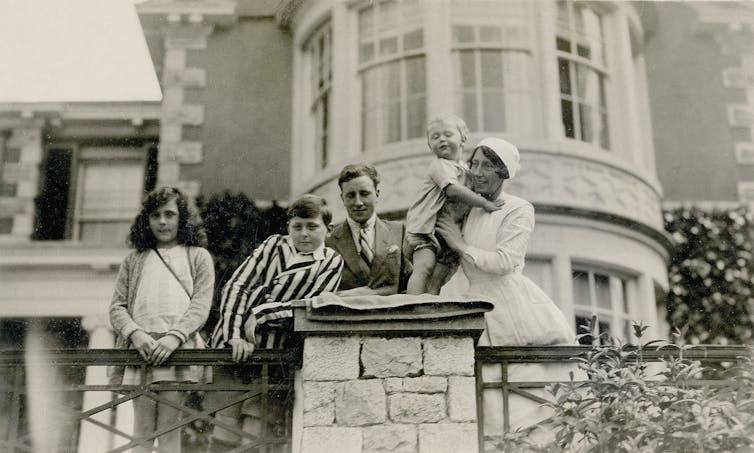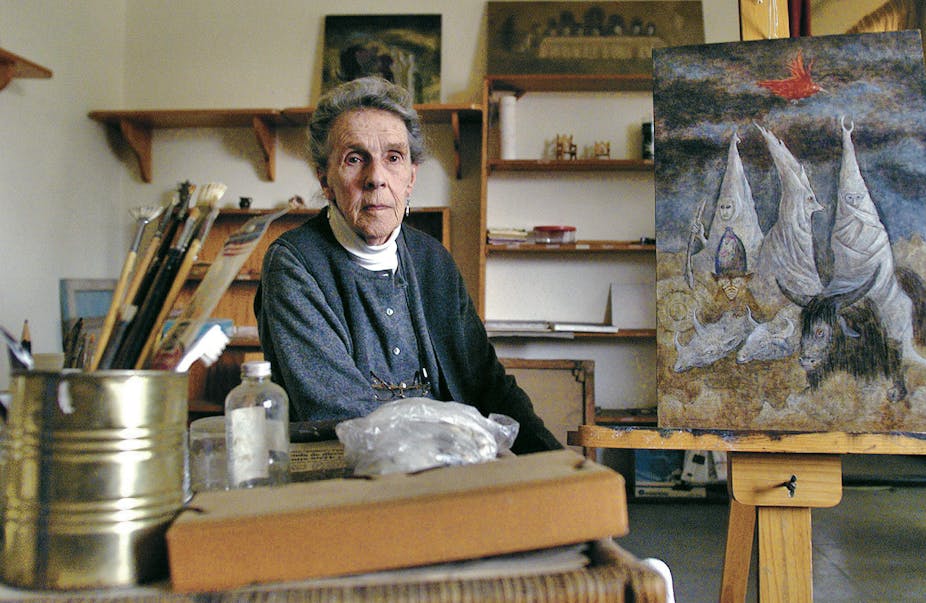Surreal Spaces: The Life and Art of Leonora Carrington, Joanna Moorhead’s latest book on the pioneering surrealist painter and writer who lived from 1917 to 2011, captures a wave of fascination for surrealist women artists.
Carrington’s many selves dazzle at every turn in this evocative study of the spaces and places of the artist’s life and work. It showcases her resilience, zest, intellectual curiosity and defiant pursuit of personal autonomy and uncompromising artistic authenticity.
Moorhead, whose father was Carrington’s cousin, offers an immersive reading of each place Carrington lived in, capturing their distinct atmospheres and registering the passage of time. She also detects the spirit of each place in Carrington’s surrealist landscape paintings, where the real and the fantastic meet mesmerically.
The journey begins with Carrington’s Anglo-Irish childhood in Cockerham, Lancaster, spent in mock-Gothic halls brimming with Celtic mystery and legend. It continues through her rebellious convent school days and her “refusenik debutante” phase. Sheathed in white satin and chaperoned by her mother Maurie, Carrington was presented to London high society in 1935, but kicked back against the culture of privilege and expectation.
There followed her art training at the Ozenfant Academy in London, and her inaugural encounter with surrealism – notably with future husband Max Ernst’s art (and subsequently with Ernst himself) – at the first International Surrealist Exhibition in 1936.
Living with Ernst in the creative and emotional hothouse of Paris led to a strong friendship with the Argentine-Italian painter Leonor Fini and to fisticuffs with Ernst’s then-wife, who was consumed by jealousy at his affair with the beautiful, headstrong and much younger Carrington.
Moorhead captures a vivid sense of the creative communities where Carrington shaped ideas, forged artistic and personal affinities, and resisted the paternalism and patronising of the surrealist men. It also explores her relationship with her father, a self-made industrialist intent on his daughter realising his social ambitions for the family.

Moorhead tracks her subject from her native Lancashire to the Americas via a summer retreat at Lambe Creek in Cornwall. There, Carrington enjoyed artistic ideas and hedonism in the company of photographer Lee Miller, poet Paul and model Nusch Éluard, and artists Roland Penrose and Man Ray.
From there, the author explores Carrington’s life and work at Saint-Martin d’Ardèche, the village home in remote southern France she shared with Ernst in the early days of the Nazi occupation. Its walls became an enduring canvas for their art, before the two were separated by Ernst’s (second) imprisonment as an “enemy alien”.
Carrington in Mexico
Surrealist Spaces spans myriad other destinations including Mexico City and the American north-east. The central chapters document Carrington’s intellectual and personal flourishing in international cultural hubs.

There was her medieval and Renaissance revelation on an early educational visit to Florence, where she was mesmerised by the art of Cimabue and Piero della Francesca. The creative communities of New York and Chicago sustained her midlife – but her sense of being at home, authentically, was achieved in Mexico City.
There, a happy second marriage and the raising of two sons combined with enlivening encounters that spanned the Mexican muralist tradition and the compelling feminist lifestyle of Frida Kahlo.
Moorhead also plots her subject’s affective development: the childhood unease and rebellion, the young painter’s passion and angst, the mature woman’s vision and pragmatism, and the aged artist’s generosity of spirit and irony.
Carrington’s discovery of nature – and of human nature – is captured through the exquisite reproductions of her work. Across her formative phases, Moorhead describes each selected artwork discerningly, attentive to colour, textures, atmosphere, symbolism and the narrative freight of each piece.

We learn that the artist’s lifelong fascination with avian, equine and organic motifs was nourished by the woodland freedom that was the flipside of the emotionally chilly upbringing at Crookhey Hall in Cockerham. Her representation of tortured souls and visions of adversity and trauma were shaped by extreme real-life experiences of loss, separation, and the terror of her confinement in a Santander asylum, where she was subjected to seizure-inducing drugs.
Down Below, Carrington’s painted account of her psychiatric experience (encouraged by French writer André Breton, who had denounced psychiatric medicine in his iconic narrative Nadja in 1928) is an indictment of institutional and clinical abuse that resonates today.

The episode illustrates Carrington’s capacity for extrication from the family tentacles that reached out to entrap her, in the hope of a cure for her “madness” or, at least, social containment of a “disreputable” daughter.
Moorhead’s book is a major sense-making project that unfolds slowly, taking readers vividly – sometimes viscerally – into the places and phases of Carrington’s biography. She invites us to imagine their influence on the development of the artist and writer, always weaving the intricate mesh of her life and work.
Surreal Spaces paints a portrait of fragility and strength, passion and determination, and Carrington’s resolute sense of the geographical, artistic and emotional place she wanted to occupy at every stage of her life.

